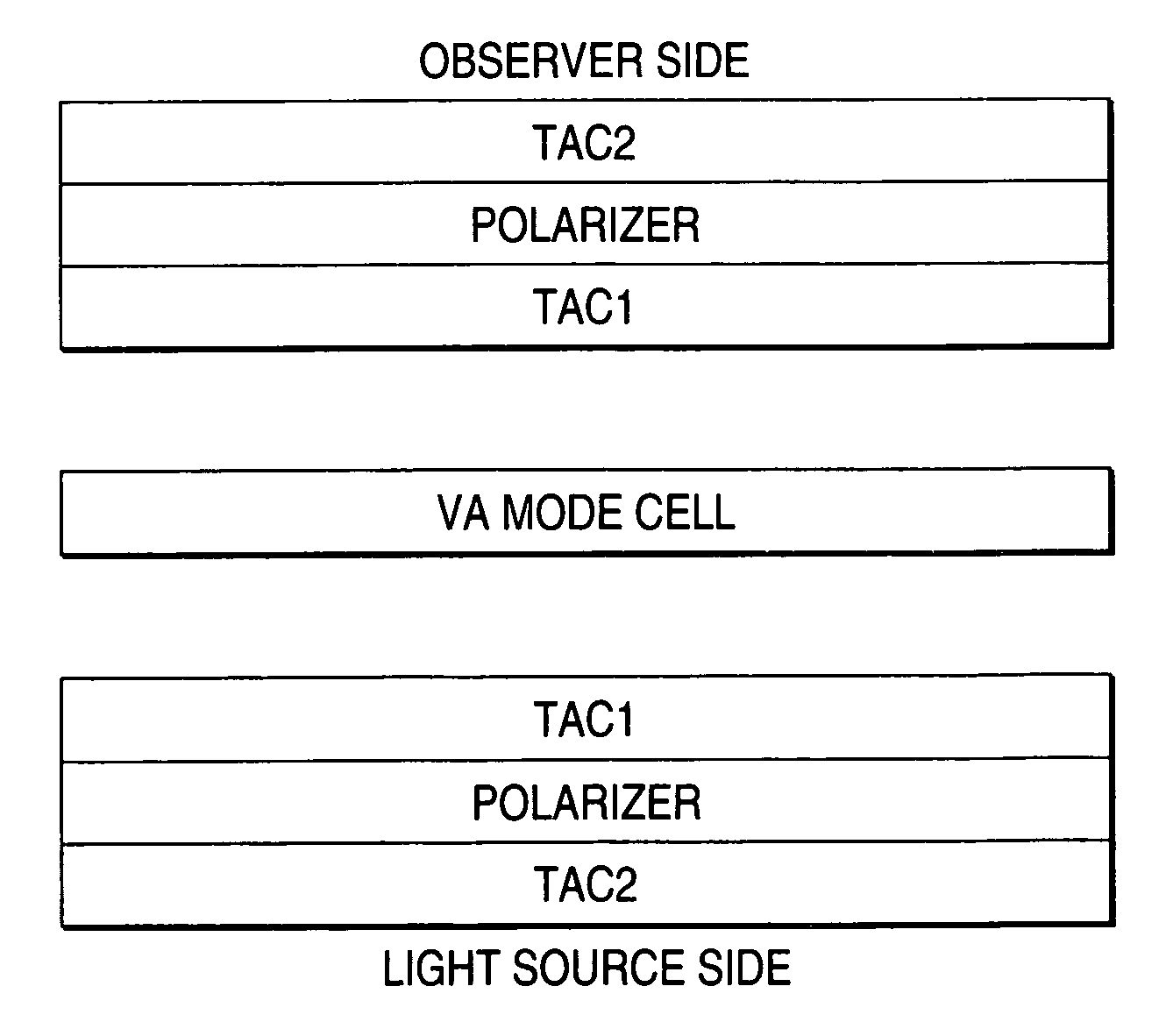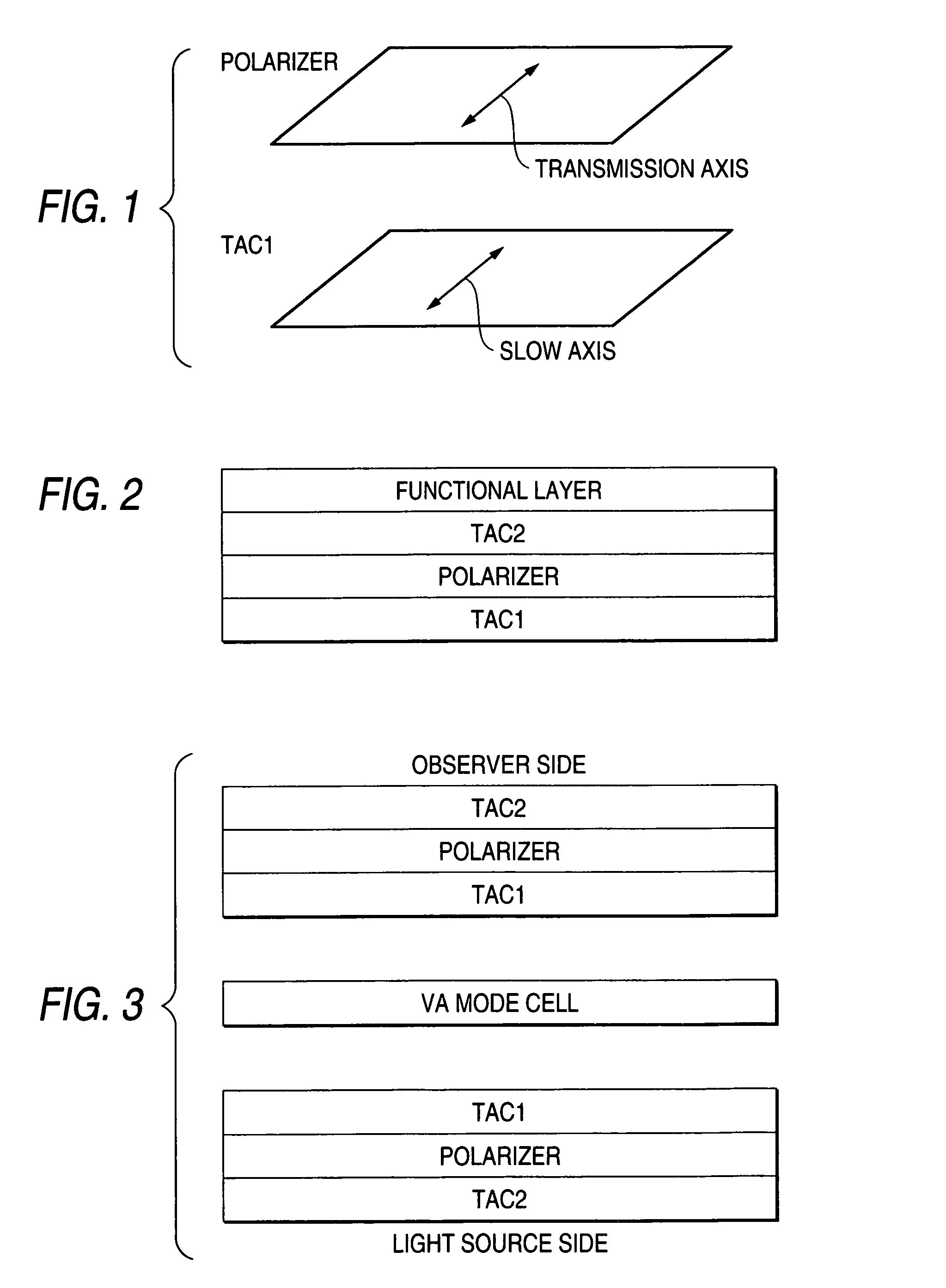Optical cellulose acylate film, polarizing plate and liquid crystal display
a technology of optical cellulose and acylate film, which is applied in the direction of polarizing elements, instruments, transportation and packaging, etc., can solve the problems of affecting the optical compensatory function the re retardation value and rth retardation value of the optical compensator, and the optical compensatory ability thereof also varies, so as to achieve little change in viewing angle characteristics, and favorable retardation values
- Summary
- Abstract
- Description
- Claims
- Application Information
AI Technical Summary
Benefits of technology
Problems solved by technology
Method used
Image
Examples
example 1
1. Formation of Cellulose Acylate Film
(1) Cellulose Acylate
[0398]Cellulose acylates differing in acyl group type and the degree of substitution by an acyl group from each other as listed in Table 1 were prepared. After adding sulfuric acid (7.8 parts by weight per 100 parts by weight of cellulose) serving as a catalyst, each carboxylic acid providing the corresponding acyl substituent was added and the acylation was carried out at 40° C. Next, the total degree of substitution and the degree of substitution at the 6-position were regulated by controlling the amount of the sulfuric acid catalyst, the water content and the aging time. Aging was performed at 40° C. Subsequently, low-molecular weight components of cellulose acylate were washed off with acetone.
(2) Preparation of Dope
(2)-1 Cellulose Acylate Solution
[0399]The following cellulose acylate composition was poured into a mixing tank and individual components were dissolved under stirring. After heating to 90° C. for about 10 mi...
example 2
(Construction of Polarizing Plate 01)
[0429]Iodine was adsorbed by a stretched polyvinyl alcohol film to form a polarizer.
[0430]The cellulose acylate films prepared in EXAMPLE 1 (1-1 to 1-41 and 1-1c to 1-3c: corresponding to TAC1 in FIGS. 1 to 3) were each bonded to one side of the polarizer similar to TAC1 in FIG. 2 with the use of a polyvinyl alcohol-based adhesive. Saponification was carried out under the following conditions.
[0431]A 1.5 mol / L aqueous solution of sodium hydroxide was prepared and maintained at 55° C. A 0.005 mol / L dilute aqueous solution of sulfuric acid was prepared and maintained at 35° C. The cellulose acylate film thus prepared was dipped in the aqueous sodium hydroxide solution for 2 minutes and then dipped in water to thereby sufficiently wash away the aqueous sodium hydroxide solution. Subsequently, it was dipped in the above dilute aqueous sulfuric acid solution for 1 minute and then dipped in water to thereby sufficiently wash away the dilute aqueous sul...
example 3
(Mounting on TN Panel)
[0463]A pair of polarizing plates provided in a liquid crystal display (6E-A3, manufactured by SHARP CORPORATION) using a TN mode liquid crystal cell were stripped off. As substitutes therefor, the polarizing plates A1-16 and A1-2c constructed in EXAMPLE 2 were bonded in such a manner that the films prepared in EXAMPLE 2 were located in the liquid crystal cell side (the slow axes of A1-16 and A1-2c agreeing with the absorption axis of the polarizer). After allowing to stand under environmental temperature-humidity conditions (25° C. and 10% RH, 25° C. and 80% RH) each for 1 month, A1-2c showed remarkable lowering in panel contrast in each of the cases, compared with A1-16. A1-16 was superior in viewing angle characteristics to A1-2c. These results indicate that, with the passage of time, both of the polarizing plates suffered from changes in the optical characteristics and A1-16, which suffered from smaller changes than A1-2c, showed less lowering in panel cont...
PUM
| Property | Measurement | Unit |
|---|---|---|
| thickness | aaaaa | aaaaa |
| glass transition temperature Tg | aaaaa | aaaaa |
| elastic modulus | aaaaa | aaaaa |
Abstract
Description
Claims
Application Information
 Login to View More
Login to View More - R&D
- Intellectual Property
- Life Sciences
- Materials
- Tech Scout
- Unparalleled Data Quality
- Higher Quality Content
- 60% Fewer Hallucinations
Browse by: Latest US Patents, China's latest patents, Technical Efficacy Thesaurus, Application Domain, Technology Topic, Popular Technical Reports.
© 2025 PatSnap. All rights reserved.Legal|Privacy policy|Modern Slavery Act Transparency Statement|Sitemap|About US| Contact US: help@patsnap.com



